35.3: 中枢神经系统
- Page ID
- 202722
培养技能
- 在大脑图上识别脊髓、脑叶和其他大脑区域
- 描述脊髓、脑叶和其他大脑区域的基本功能
中枢神经系统(CNS)由大脑组成,其中一部分如图\(\PageIndex{1}\)和脊髓所示,上面覆盖着三层称为脑膜的保护罩(来自希腊语中的膜)。 最外层是 dura mater(拉丁语意为 “硬妈妈”)。 正如拉丁语所暗示的那样,这层厚层的主要功能是保护大脑和脊髓。 硬脑膜还含有静脉样结构,可将血液从大脑带回心脏。 中间层是网状的蛛网状物质。 最后一层是 pia mater(拉丁语意为 “软妈妈”),它像保鲜膜一样直接接触并覆盖大脑和脊髓。 蛛网膜和 pia maters 之间的空间充满了脑脊液(CSF)。 脑脊液由一种称为脉络丛的组织产生,该组织位于中枢神经系统中充满液体的隔室中,称为心室。 大脑漂浮在脑脊液中,脑脊液起到缓冲和减震器的作用,使大脑具有中性活力。 脑脊液还有将化学物质循环到整个大脑和脊髓中的作用。
整个大脑仅含有大约8.5汤匙的脑脊液,但脑脊液经常在心室中产生。 当心室阻塞时,这会产生问题——脑脊液积聚并造成肿胀,大脑被推向头骨。 这种肿胀状况被称为脑积水(“水头”),如果不插入分流器来清除液体和压力,可能会导致癫痫发作、认知问题甚至死亡。
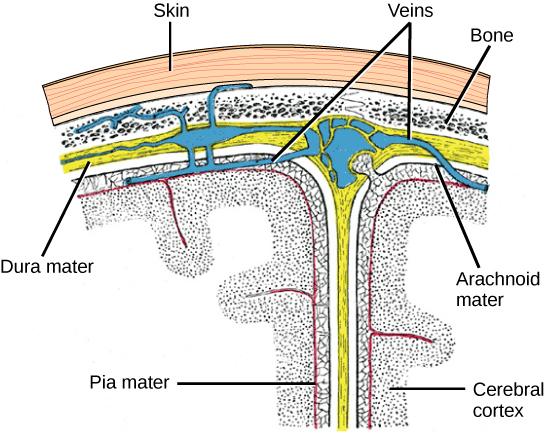
大脑
大脑是中枢神经系统的一部分,包含在头骨的颅腔中。 它包括大脑皮层、边缘系统、基底神经节、丘脑、下丘脑和小脑。 为了观察内部结构,可以通过三种不同的方式对大脑进行分割:矢状截面从左向右切割大脑,如图\(\PageIndex{2}\) b 所示;冠状截面从前向后切割大脑,如图\(\PageIndex{2}\) a 所示;水平截面从上到下切开大脑。
大脑皮层
大脑的最外层是一块厚厚的神经系统组织,称为大脑皮层,它被折叠成叫做 gyri(单数:gyr us)的山丘和叫做 sulci(单数:s ulc us)的山谷。 皮层由两个半球组成——右半球和左半球——由一个大沟隔开。 一个叫做 callosum 语料库(拉丁语:“tough body”)的厚纤维束将两个半球连接起来,允许信息从一侧传递到另一侧。 尽管有些大脑功能更多地局限于一个半球而不是另一个半球,但两个半球的功能在很大程度上是多余的。 实际上,有时(非常罕见)整个半球都被切除以治疗严重的癫痫。 尽管患者在手术后确实会出现一些缺陷,但令人惊讶的是,他们几乎没有出现任何问题,尤其是在对神经系统非常不成熟的孩子进行手术时。
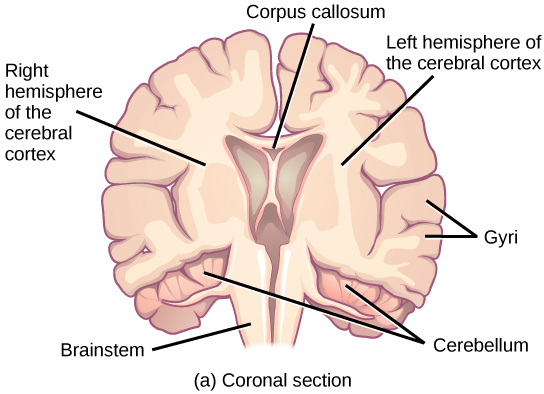
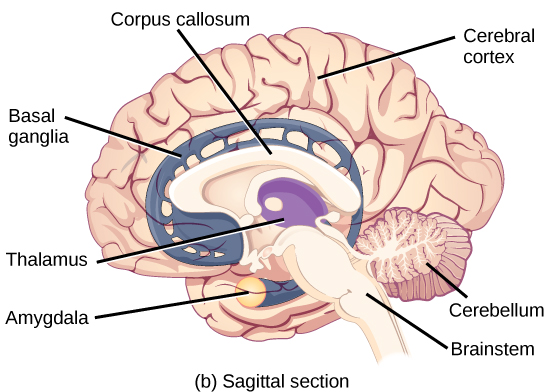
在其他治疗严重癫痫的手术中,切开了 callosum 语料库,而不是切除整个半球。 这会导致一种称为脑分裂的疾病,它可以深入了解两个半球的独特功能。 例如,当一个物体出现在患者的左视野中时,他们可能无法口头命名该物体(并且可能声称根本没有看见物体)。 这是因为来自左视野的视觉输入穿过并进入右半球,然后无法向语音中心发出信号,而语音中心通常位于大脑的左侧。 值得注意的是,如果要求脑裂患者用左手从一组物体中捡起特定的物体,患者将能够做到这一点,但仍然无法通过声音识别它。
每个皮质半球都包含称为叶片的区域,这些区域参与不同的功能。 科学家使用各种技术来确定哪些大脑区域与不同的功能有关:他们检查受伤或患有影响特定区域的疾病的患者,并了解这些区域与功能缺陷的关系。 他们还进行动物研究,刺激大脑区域,看看行为是否有任何改变。 他们使用一种称为跨磁刺激(TMS)的技术,使用放置在头部的强磁体暂时停用皮层的特定部位;他们使用功能性磁共振成像(fMRI)来观察与之相关的特定大脑区域的含氧血流的变化特定的行为任务。 这些技术以及其他技术使人们对不同大脑区域的功能有了深刻的了解,但也表明,任何给定的大脑区域都可能参与多个行为或过程,任何给定的行为或过程通常都涉及多个大脑区域的神经元。 话虽如此,哺乳动物大脑皮层的每个半球都可以分解为四个功能和空间上定义的叶:额叶、顶叶、腱叶和枕叶。 图\(\PageIndex{3}\) illustrates these four lobes of the human cerebral cortex.

The frontal lobe is located at the front of the brain, over the eyes. This lobe contains the olfactory bulb, which processes smells. The frontal lobe also contains the motor cortex, which is important for planning and implementing movement. Areas within the motor cortex map to different muscle groups, and there is some organization to this map, as shown in Figure \(\PageIndex{4}\). For example, the neurons that control movement of the fingers are next to the neurons that control movement of the hand. Neurons in the frontal lobe also control cognitive functions like maintaining attention, speech, and decision-making. Studies of humans who have damaged their frontal lobes show that parts of this area are involved in personality, socialization, and assessing risk.

The parietal lobe is located at the top of the brain. Neurons in the parietal lobe are involved in speech and also reading. Two of the parietal lobe’s main functions are processing somatosensation—touch sensations like pressure, pain, heat, cold—and processing proprioception—the sense of how parts of the body are oriented in space. The parietal lobe contains a somatosensory map of the body similar to the motor cortex.
The occipital lobe is located at the back of the brain. It is primarily involved in vision—seeing, recognizing, and identifying the visual world.
The temporal lobe is located at the base of the brain by your ears and is primarily involved in processing and interpreting sounds. It also contains the hippocampus (Greek for “seahorse”)—a structure that processes memory formation. The hippocampus is illustrated in Figure \(\PageIndex{6}\). The role of the hippocampus in memory was partially determined by studying one famous epileptic patient, HM, who had both sides of his hippocampus removed in an attempt to cure his epilepsy. His seizures went away, but he could no longer form new memories (although he could remember some facts from before his surgery and could learn new motor tasks).
Evolution Connection: Cerebral Cortex
Compared to other vertebrates, mammals have exceptionally large brains for their body size. An entire alligator’s brain, for example, would fill about one and a half teaspoons. This increase in brain to body size ratio is especially pronounced in apes, whales, and dolphins. While this increase in overall brain size doubtlessly played a role in the evolution of complex behaviors unique to mammals, it does not tell the whole story. Scientists have found a relationship between the relatively high surface area of the cortex and the intelligence and complex social behaviors exhibited by some mammals. This increased surface area is due, in part, to increased folding of the cortical sheet (more sulci and gyri). For example, a rat cortex is very smooth with very few sulci and gyri. Cat and sheep cortices have more sulci and gyri. Chimps, humans, and dolphins have even more.
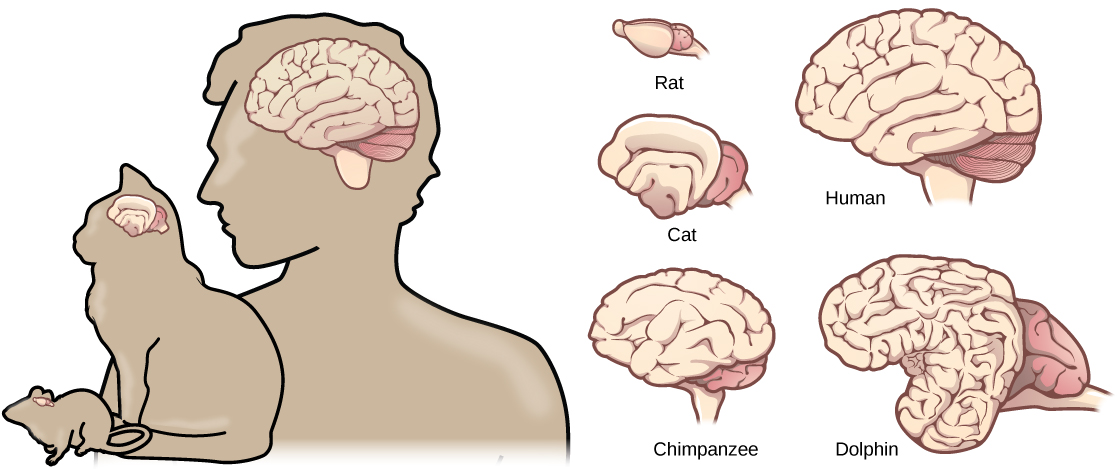
Basal Ganglia
Interconnected brain areas called the basal ganglia (or basal nuclei) play important roles in movement control and posture. Damage to the basal ganglia, as in Parkinson’s disease, leads to motor impairments like a shuffling gait when walking. The basal ganglia also regulate motivation. For example, when a wasp sting led to bilateral basal ganglia damage in a 25-year-old businessman, he began to spend all his days in bed and showed no interest in anything or anybody. But when he was externally stimulated—as when someone asked to play a card game with him—he was able to function normally. Interestingly, he and other similar patients do not report feeling bored or frustrated by their state.
Thalamus
The thalamus (Greek for “inner chamber”), illustrated in Figure \(\PageIndex{6}\), acts as a gateway to and from the cortex. It receives sensory and motor inputs from the body and also receives feedback from the cortex. This feedback mechanism can modulate conscious awareness of sensory and motor inputs depending on the attention and arousal state of the animal. The thalamus helps regulate consciousness, arousal, and sleep states. A rare genetic disorder called fatal familial insomnia causes the degeneration of thalamic neurons and glia. This disorder prevents affected patients from being able to sleep, among other symptoms, and is eventually fatal.
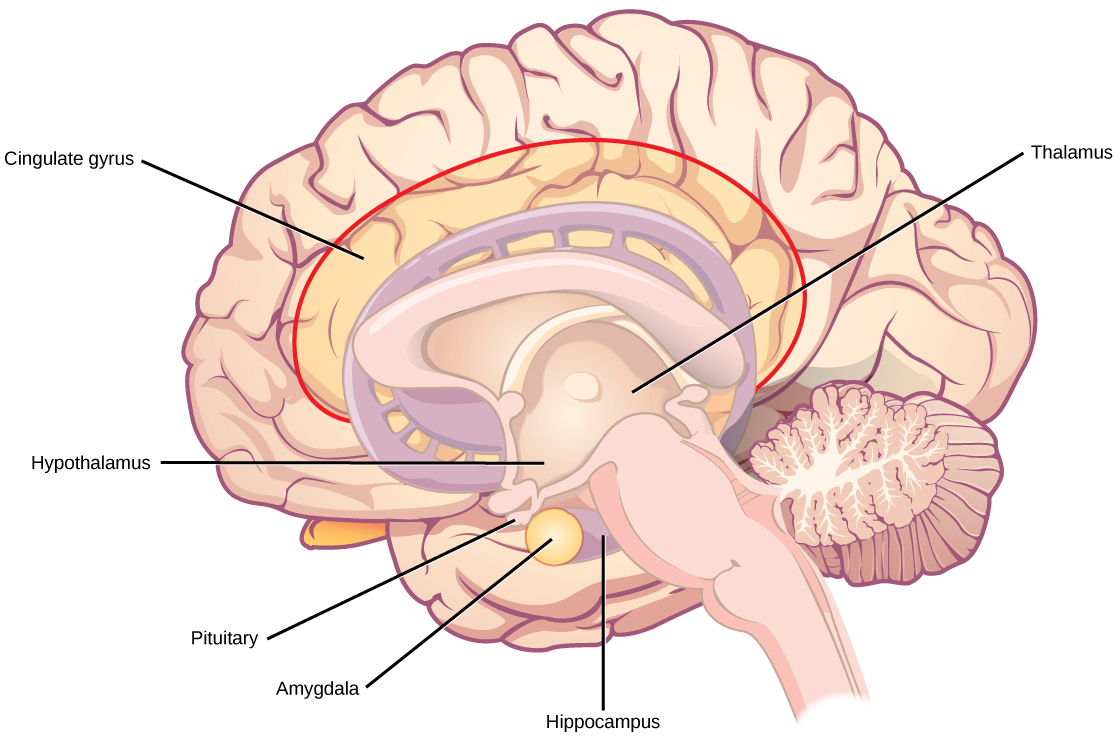
Hypothalamus
Below the thalamus is the hypothalamus, shown in Figure \(\PageIndex{6}\). The hypothalamus controls the endocrine system by sending signals to the pituitary gland, a pea-sized endocrine gland that releases several different hormones that affect other glands as well as other cells. This relationship means that the hypothalamus regulates important behaviors that are controlled by these hormones. The hypothalamus is the body’s thermostat—it makes sure key functions like food and water intake, energy expenditure, and body temperature are kept at appropriate levels. Neurons within the hypothalamus also regulate circadian rhythms, sometimes called sleep cycles.
Limbic System
The limbic system is a connected set of structures that regulates emotion, as well as behaviors related to fear and motivation. It plays a role in memory formation and includes parts of the thalamus and hypothalamus as well as the hippocampus. One important structure within the limbic system is a temporal lobe structure called the amygdala (Greek for “almond”), illustrated in Figure \(\PageIndex{6}\). The two amygdala are important both for the sensation of fear and for recognizing fearful faces. The cingulate gyrus helps regulate emotions and pain.
Cerebellum
The cerebellum (Latin for “little brain”), shown in Figure \(\PageIndex{3}\), sits at the base of the brain on top of the brainstem. The cerebellum controls balance and aids in coordinating movement and learning new motor tasks.
Brainstem
The brainstem, illustrated in Figure \(\PageIndex{3}\), connects the rest of the brain with the spinal cord. It consists of the midbrain, medulla oblongata, and the pons. Motor and sensory neurons extend through the brainstem allowing for the relay of signals between the brain and spinal cord. Ascending neural pathways cross in this section of the brain allowing the left hemisphere of the cerebrum to control the right side of the body and vice versa. The brainstem coordinates motor control signals sent from the brain to the body. The brainstem controls several important functions of the body including alertness, arousal, breathing, blood pressure, digestion, heart rate, swallowing, walking, and sensory and motor information integration.
Spinal Cord
Connecting to the brainstem and extending down the body through the spinal column is the spinal cord, shown in Figure \(\PageIndex{3}\). The spinal cord is a thick bundle of nerve tissue that carries information about the body to the brain and from the brain to the body. The spinal cord is contained within the bones of the vertebrate column but is able to communicate signals to and from the body through its connections with spinal nerves (part of the peripheral nervous system). A cross-section of the spinal cord looks like a white oval containing a gray butterfly-shape, as illustrated in Figure \(\PageIndex{7}\). Myelinated axons make up the “white matter” and neuron and glial cell bodies make up the “gray matter.” Gray matter is also composed of interneurons, which connect two neurons each located in different parts of the body. Axons and cell bodies in the dorsal (facing the back of the animal) spinal cord convey mostly sensory information from the body to the brain. Axons and cell bodies in the ventral (facing the front of the animal) spinal cord primarily transmit signals controlling movement from the brain to the body.
The spinal cord also controls motor reflexes. These reflexes are quick, unconscious movements—like automatically removing a hand from a hot object. Reflexes are so fast because they involve local synaptic connections. For example, the knee reflex that a doctor tests during a routine physical is controlled by a single synapse between a sensory neuron and a motor neuron. While a reflex may only require the involvement of one or two synapses, synapses with interneurons in the spinal column transmit information to the brain to convey what happened (the knee jerked, or the hand was hot).
In the United States, there around 10,000 spinal cord injuries each year. Because the spinal cord is the information superhighway connecting the brain with the body, damage to the spinal cord can lead to paralysis. The extent of the paralysis depends on the location of the injury along the spinal cord and whether the spinal cord was completely severed. For example, if the spinal cord is damaged at the level of the neck, it can cause paralysis from the neck down, whereas damage to the spinal column further down may limit paralysis to the legs. Spinal cord injuries are notoriously difficult to treat because spinal nerves do not regenerate, although ongoing research suggests that stem cell transplants may be able to act as a bridge to reconnect severed nerves. Researchers are also looking at ways to prevent the inflammation that worsens nerve damage after injury. One such treatment is to pump the body with cold saline to induce hypothermia. This cooling can prevent swelling and other processes that are thought to worsen spinal cord injuries.

Summary
The vertebrate central nervous system contains the brain and the spinal cord, which are covered and protected by three meninges. The brain contains structurally and functionally defined regions. In mammals, these include the cortex (which can be broken down into four primary functional lobes: frontal, temporal, occipital, and parietal), basal ganglia, thalamus, hypothalamus, limbic system, cerebellum, and brainstem—although structures in some of these designations overlap. While functions may be primarily localized to one structure in the brain, most complex functions, like language and sleep, involve neurons in multiple brain regions. The spinal cord is the information superhighway that connects the brain with the rest of the body through its connections with peripheral nerves. It transmits sensory and motor input and also controls motor reflexes.
Glossary
- amygdala
- structure within the limbic system that processes fear
- arachnoid mater
- spiderweb-like middle layer of the meninges that cover the central nervous system
- basal ganglia
- interconnected collections of cells in the brain that are involved in movement and motivation; also known as basal nuclei
- basal nuclei
- see basal ganglia
- brainstem
- portion of the brain that connects with the spinal cord; controls basic nervous system functions like breathing, heart rate, and swallowing
- cerebellum
- brain structure involved in posture, motor coordination, and learning new motor actions
- cerebral cortex
- outermost sheet of brain tissue; involved in many higher-order functions
- choroid plexus
- spongy tissue within ventricles that produces cerebrospinal fluid
- cingulate gyrus
- helps regulate emotions and pain; thought to directly drive the body’s conscious response to unpleasant experiences
- corpus callosum
- thick fiber bundle that connects the cerebral hemispheres
- cerebrospinal fluid (CSF)
- clear liquid that surrounds the brain and spinal cord and fills the ventricles and central canal; acts as a shock absorber and circulates material throughout the brain and spinal cord.
- dura mater
- tough outermost layer that covers the central nervous system
- frontal lobe
- part of the cerebral cortex that contains the motor cortex and areas involved in planning, attention, and language
- gyrus
- (plural: gyri) ridged protrusions in the cortex
- hippocampus
- brain structure in the temporal lobe involved in processing memories
- hypothalamus
- brain structure that controls hormone release and body homeostasis
- limbic system
- connected brain areas that process emotion and motivation
- meninge
- membrane that covers and protects the central nervous system
- occipital lobe
- part of the cerebral cortex that contains visual cortex and processes visual stimuli
- parietal lobe
- part of the cerebral cortex involved in processing touch and the sense of the body in space
- pia mater
- thin membrane layer directly covering the brain and spinal cord
- proprioception
- sense about how parts of the body are oriented in space
- somatosensation
- sense of touch
- spinal cord
- thick fiber bundle that connects the brain with peripheral nerves; transmits sensory and motor information; contains neurons that control motor reflexes
- sulcus
- (plural: sulci) indents or “valleys” in the cortex
- temporal lobe
- part of the cerebral cortex that processes auditory input; parts of the temporal lobe are involved in speech, memory, and emotion processing
- thalamus
- brain area that relays sensory information to the cortex
- ventricle
- cavity within brain that contains cerebrospinal fluid



